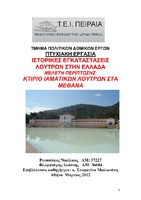| dc.contributor.advisor | Μαλικούτη, Σταματίνα | |
| dc.contributor.author | Ρουσσάκος, Νικόλαος | |
| dc.contributor.author | Φλαμπούρης, Ιωάννης | |
| dc.date.accessioned | 2013-09-18T11:36:55Z | |
| dc.date.available | 2013-09-18T11:36:55Z | |
| dc.date.issued | 2012-03 | |
| dc.identifier.uri | http://okeanis.lib2.uniwa.gr/xmlui/handle/123456789/317 | |
| dc.description.abstract | Η Ελλάδα είναι μια από τις πιο πλούσιες σε ιαματικές πηγές χώρα και τα ιαματικά νερά που διαθέτει έχουν ποικίλη φυσικοχημική σύσταση. Το γεγονός αυτό αναφέρεται και στην Αρχαία ελληνική μυθολογία όπου ξεχωρίζουν σχετικές αναφορές για τις θεραπευτικές ιδιότητες των ιαματικών πηγών στις οποίες οι αρχαίοι έλληνες πίστευαν ότι κατοικούσαν οι θεοί. Η λουτροθεραπεία επίσης ήταν γνωστή από τα αρχαία χρόνια και χαρακτηριστικά παραδείγματα αποτελούν τα Ασκληπιεία τα οποία κτίζονταν κοντά σε ιαματικές πηγές και χρησιμοποιούσαν τα ιαματικά νερά για θεραπευτικούς σκοπούς, οι ιαματικές πηγές των Θερμοπυλών, της Αιδηψού κ.ά. Τη χρήση των ιαματικών νερών για την αντιμετώπιση διαφόρων παθήσεων τη συναντάμε αργότερα και κατά τους Ρωμαιοβυζαντινούς χρόνους αλλά και σήμερα.
Εκτός από τα ιαματικά λουτρά ιδιαίτερη άνθηση είχαν και τα λουτρά υγιεινής και καθαριότητας εγκαταστάσεις των οποίων σώζονται ακόμα και σήμερα σε πολλά σημεία της Ελλάδας (αρχαία Ολυμπία, ιερό Αφαίας στην Αίγινα κ.ά.). Τα πιο οργανωμένα αρχαιοελληνικά λουτρά ήταν τα Βαλανεία με χαρακτηριστικά μέρη το χώρο των θερμών λουτρών και το πυριατήριο, καθώς και συστήματα θέρμανσης και ύδρευσης. Ειδικά η Θόλος (στρογγυλός θάλαμος για τα ζεστά λουτρά) είναι το πιο χαρακτηριστικό αρχιτεκτονικό στοιχείο των αρχαίων ελληνικών λουτρών. Στους Ρωμαϊκούς χρόνους ως λουτρά λειτουργούσαν τα Ρωμαϊκά Βαλανεία και οι Θέρμες. Τα συγκροτήματα αυτά διέθεταν αποδυτήρια, χώρους ανάπαυσης, χώρους θερμών και ψυχρών λουτρών, πισίνες κ.ά. και είχαν ιδιαίτερα αναπτυγμένο το σύστημα θέρμανσής τους με υπόκαυστα. Παρόμοιας μορφής με τα Ρωμαϊκά λουτρά βρίσκουμε τόσο κατά την Βυζαντινή όσο και κατά την Οθωμανική περίοδο. Στη χώρα μας σήμερα σώζονται σε αρκετά καλή κατάσταση πολλά από τα οθωμανικά λουτρά –χαμάμ όπως το Bey hamam στη Θεσσαλονίκη, το λουτρό των Αέρηδων στην Αθήνα κ.ά.
Ξεχωριστής σημασίας κτίριο για ιαματικά λουτρά είναι το ιστορικό κτίριο των λουτρών στα Μέθανα το οποίο ξεχωρίζει για την αρχιτεκτονική και τη λειτουργικότητά του. Στην εργασία παρατίθενται τα αρχιτεκτονικά σχέδια του κτιρίου (κατόψεις και όψεις), φωτογραφίες του κτιρίου (εσωτερικά και εξωτερικά) και τα στοιχεία κατασκευής της αντίστοιχης μακέτας του. | el |
| dc.format.extent | 83 σελ. | el |
| dc.language.iso | el | el |
| dc.publisher | ΤΕΙ Πειραιά | el |
| dc.rights | Αναφορά Δημιουργού-Μη Εμπορική Χρήση-Όχι Παράγωγα Έργα 3.0 Ελλάδα | * |
| dc.rights.uri | http://creativecommons.org/licenses/by-nc-nd/3.0/gr/ | * |
| dc.subject | TPSH::Τεχνολογία::Δομική Μηχανική::Κατασκευές | el |
| dc.title | Ιστορικές εγκαταστάσεις λουτρών στην Ελλάδα. Μελέτη περίπτωσης: Κτίριο ιαματικών λουτρών στα Μέθανα | el |
| dc.type | Πτυχιακή εργασία | el |
| dc.contributor.department | Τμήμα Πολιτικών Δομικών Έργων | el |
| dc.contributor.faculty | Σχολή Τεχνολογικών Εφαρμογών | el |
| dc.subject.keyword | Λουτρά | el |
| dc.subject.keyword | Ιαματικά λουτρά | el |
| dc.subject.keyword | Μέθανα | el |
| dc.description.abstracttranslated | Greece is one of the richest countries in hot springs and the thermal waters that exist in it have various physiochemical compositions. This fact is mentioned in Ancient Greek Mythology, where specific mentions are distinguished about the healing nature of the hot springs in which the Ancient Greeks believed that their gods lived. Balneotherapy was also known since ancient times, and particular examples include the ‘Asklipieia’ which were built near hot springs and would use the waters for healing, the hot springs of Thermopylae, of Aidipsos etc. The use of hot springs for dealing with various illnesses can be found later during the Romeo-Byzantine ages and also today.
Besides hot springs there was a significant bloom in the use of baths of hygiene and cleanliness, installations of which can still be seen these days in many parts of Greece (ancient Olympia, sanctuary of Afaia in Aigina etc). The most organized ancient greek baths were the ‘valaneia’, their particular parts being the room of the hot baths and the ‘pyriatirio’, as well as systems of heating and water supply. Especially the ‘Tholos’ (round chamber for the hot baths) is the most particular architectural element of the ancient greek baths. In the Roman times, the ‘Roman valaneia’ and the ‘Thermae’ would be used as baths. These compounds were composed of bestiaries, resting places, places of hot and cold baths, pools etc, and had a particularly developed heating system using hypocausts. Of similar form with the Roman baths, are the baths of the Byzantine and Ottoman times. In our country there are still many ottoman baths-hamam in good condition like the Bey hamam in Salonica, the bath of the winds in Athens etc.
A building of special meaning for spas is the historic building of the baths in Methana, which distinguishes itself from the rest due to its architecture and functionality. In this project we show the architectural designs of the building (plans and views), photos of the building (internal and external) and the construction elements of the corresponding layout. | en |


